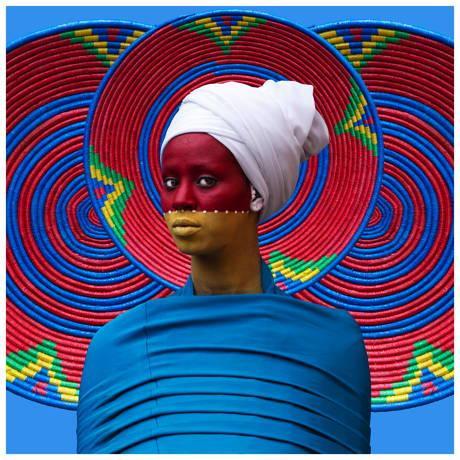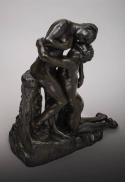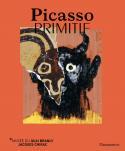Art Of The Day Weekly
#466 - from 30 March 2017 to 5 April 2017

Aida Muluneh, City Life, 2016. Photograph, 80 x 80 cm. Image courtesy of David Krut Projects.
IN THE AIR
Africa, the new superpower of art
PARIS – When asked to give the name of an African artist fifty years ago, most of us would have remained silent. Things have really changed. Exhibitions such as “Magiciens de la Terre” in 1989 at the Centre Pompidou and more recently, “Beauté Congo” at the Fondation Cartier (2015), specific contemporary art fairs such as 1:54 in London or AKAA in Paris, have unveiled a much more dense fabric of creators, far beyond the Dogon lock sculptors or the Bamiléké pearl finery. Chéri Samba (from Congo), Barthélemy Toguo (from Cameroon), El Anatsui (fro Ghana), or Ethiopian Julie Mehretu, settled in the U.S.A. are part of this visible avant-garde. Behind it lies a new, ill-known generation. From Algeria to Egypt, from Sudan all the way to Malawi and Madagascar, African art can no longer be summed up to a picturesque craftsmanship or a naïve painting. Actually, one of the declared objectives of the “100% Africa” festival is to unveil new names. Some of them use traditional techniques - tapestry or sculpture -, others take a try at photography, video, performance, installation, or conceptual art, all fields implicitly reserved for Western artists. The exhibition of the Pigozzi collection at the Fondation Louis Vuitton, starting 26 April, will undoubtedly not be the phenomenal success the Shchukin collection was but it will confirm African art is no longer the poor cousin.
• Afriques Capitales, at the Grande Halle de la Villette, from 29 March to 28 May 2017. A second part is shown at the gare Saint-Sauveur in Lille, from 6 April to 3 September 2017.
EXHIBITIONS

Kneeling Archer (detail), Qin Dynasty (221–206 B.C.). Earthenware. Qin Shihuangdi Mausoleum Site Museum, Lintong
The Han, a never-ending fascination
NEW YORK – The Han dynasty had already been admired recently, in 2015, at the Musée Guimet, in Paris. This Chinese civilisation, which flowered two thousand years ago (from 221 B.C. to 220 A.D.), continues to fascinate us today by the use of precious materials such as jade, lacquer, gold or rock crystal, by the skill in working with bronze and terracotta (the famous horses), by the impassivity of characters prior to the Roman Empire. The exhibition that also includes the short Qin season that preceded the Han (the one which produced the 7, 000 warriors in terracotta) is an impressive international feat, with loans from 32 museums. It presents a scoop with the presence of a semi-nude statue, with an impressively precise anatomy that leads us to imagine relations with the Hellenistic kingdoms of Asia. Just when President Trump is making China one of his main antagonists, this exhibition shows the degree of sophistication of this Empire of builders. We owe it a system of weights and measures, a legal system, a homogeneous written language, a stable currency and efficient infrastructures (roads and canals): almost an example to follow!
• Age of Empires: Chinese Art of the Qin and Han Dynasties (221 B.C.–A.D. 220) at the Metropolitan Museum, from 3 April to 16 July 2017.
MUSEUMS

Camille Claudel, L’Abandon, ca 1886-1905, bronze, 42,3 x 38,8 x 19,9 cm. Bought to Reine-Marie Paris de La Chapelle, 2008 © musée Camille Claudel, photo Marco Illuminati.
Camille Claudel can set anchor
NOGENT-SUR-SEINE – To the French public she represents a romantic and tragic destiny, that of a female genius who fell into the claws of an ogre artist who loved her, shaped her and then destroyed her. He was Rodin, she of course was Camille Claudel (1864-1943) who Isabelle Adjani interpreted in a greatly successful movie. The accursed artist is finally being celebrated in a museum all of her own, in a town where she spent most of her youth and where she demonstrated the first signs of her talent. The museum is right next to the family home (her father was a civil servant in charge of real estate deeds), was designed by Adelfo Scaranello, and is a discreet building in glass and bricks (a symbolic material since it came from the earth young Camille worked with). Next to local sculptors among which Alfred Boucher, her mentor and the future founder of la Ruche in Paris, a few pieces by Rodin and Bourdelle, it is obviously Camille Claudel who is at the centre of the museum. It was founded on a collection bought in 2008, and presents the artist’s masterpieces, in plaster, in marble or in bronze, among them Valse, Age mûr and even theJeune Châtelaine as well as some very rare drawings. Expressionism or stylisation? Undoubtedly both, as the young artist, shown around by Rodin, proved to be very talented. But the end of their relationship triggered off the downfall of Camille who actually survived more than lived another four decades without ever again drawing or modelling.
• The Musée Camille Claudel opened on 26 March 2017.
ARTIST OF THE WEEK
Ciprian Muresan, drawing a mirror of the world
Romanian creators have a strong visual tradition, in particular in photography (cf. Brassaï, Eli Lotar). They also have shown their talent recently in movies, with a great number of rewards in festivals. Ciprian Muresan, born in 1977, takes up the torch in the field of drawing. He was twenty years old when the revolution freed his country from Ceaucescu and draws his inspiration from Masaccio as well as from Buñuel and Kippenberger. He is capable of huge compositions in charcoal similar to storyboards but which at times become huge installations. Muresan merges the past, the present and utopia. Surprisingly enough, his intensive and brilliant practice of drawing is accompanied by a conceptual aspect, in the form of videos or photos that refer to the decadence of civilisations or dictatorships (soldiers peeling potatoes), or producing remakes of Yves Klein or Maurizio Cattelan.
• Ciprian Muresan received the 10th prize of contemporary drawing from the Fondation Daniel et Florence Guerlain on 23 March 2017.
OPENINGS OF THE WEEK

Stéphane Lavoué - THE KINGDOM
30 March 2017 - PARIS - Fisheye Gallery
A personal glimpse of rural Vermont, in a new gallery dedicated to photography
BOOKS
Picasso, the great transmitter
The exhibition currently showing at the Musée du quai Branly is spectacular. It confronts Picasso to “primitive”, non-European or ancient forms of art (prehistoric or proto-historic, like the one of Iberia for example). While it gives free rein in its second part to eloquent rapprochements that show a parallel in the forms (between Picasso and Fang sculpture, Mexican cut-outs or headdresses from Vanuatu), it also presents, in its first part, a truly learned introduction. We discover that year after year, Picasso was impregnated, or rather became aware, of a shared vision. He was known to be influenced by African art, and yet it is claimed that he once answered, “Negro art? Never heard of it!” It is difficult to remember everything, to measure the impact of Carl Einstein, Michel Leiris, Derain and Vlaminck, the funny letters or notes exchanged with Gertrude Stein, the trip to Gósol in 1906 or the visit of the Musée d’Ethnographie du Trocadéro in 1907. Hence the interest of the catalogue, as it allows one to calmly review all these references, at home.
• Picasso primitif, directed by Yves Le Fur, Flammarion, 2017, 344 p., €49.90


